Polar coordinates are an alternative to
rectangular coordinates for referring to points in the plane. A point
in the plane has polar coordinates ![]() . r is
(roughly) the distance from the origin to the point;
. r is
(roughly) the distance from the origin to the point; ![]() is the angle between the radius vector for the point
and the positive x-axis. (As usual, angles are positive if measured
counterclockwise and negative if measured clockwise.)
is the angle between the radius vector for the point
and the positive x-axis. (As usual, angles are positive if measured
counterclockwise and negative if measured clockwise.)
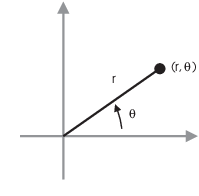
Example. Plot the points whose polar coordinates are:
(a) ![]() .
.
(b) ![]() .
.
(a) To plot ![]() , rotate the
x-axis through an angle of
, rotate the
x-axis through an angle of ![]() ---
counterclockwise, since the angle is positive. Then go out 2 units.
---
counterclockwise, since the angle is positive. Then go out 2 units.
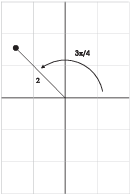
(b) To plot ![]() , rotate
the x-axis through an angle of
, rotate
the x-axis through an angle of ![]() .
.
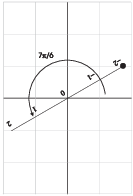
Locate the point -2 on the rotated x-axis. That is the point ![]() .
.
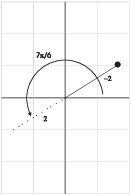
If you're plotting lots of points, you can do this rotation trick
with a ruler, or you can make a little number line out of cardboard.
If you do this, it's nearly impossible to get confused by points
which have negative r's.![]()
A point can be represented by infinitely many polar coordinate pairs.
If you add multiples of ![]() to the angle, you get the
same point. For example, these are the same point in polar
coordinates.
to the angle, you get the
same point. For example, these are the same point in polar
coordinates.
![]()
If you multiply r by -1 and add ![]() to
to ![]() , you get the same point.
, you get the same point.
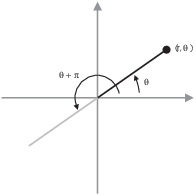
Reason: Adding ![]() to
to ![]() and multiplying r by -1 each have the effect of
"flipping" the point to the other side of the origin, so
the two changes cancel out.
and multiplying r by -1 each have the effect of
"flipping" the point to the other side of the origin, so
the two changes cancel out.
For example, these represent the same point in polar coordinates:
![]()
This phenomenon does not occur in rectangular coordinates; it can make things like finding intersection points of polar curves a bit tricky!
You can convert between rectangular and polar using the following conversion formulas:
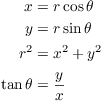
All of them come from the following standard triangle:
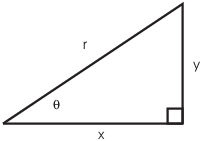
Example. Find the polar equation for the circle
![]()
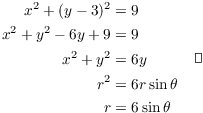
Example. (a) Find the rectangular equation for
the polar curve ![]() and identify it.
and identify it.
(b) If you start at ![]() , how far do you have to go
before the graph first closes up?
, how far do you have to go
before the graph first closes up?
(a) Multiply by r, substitute ![]() , and
complete the square:
, and
complete the square:

This is a circle of radius 2 with center at ![]() .
.![]()
(b) The entire circle is traced out as ![]() goes from 0 to
goes from 0 to ![]() .
.
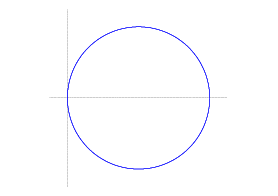
The top half of the circle is traced out from 0 to ![]() . (Draw some radius segments from the
origin out to the curve and see.) The bottom half is traced out from
. (Draw some radius segments from the
origin out to the curve and see.) The bottom half is traced out from
![]() to
to ![]() . It winds up in the
fourth quadrant instead of the second because r is negative.
. It winds up in the
fourth quadrant instead of the second because r is negative.![]()
Example. Find the points at which ![]() and
and ![]() intersect.
intersect.
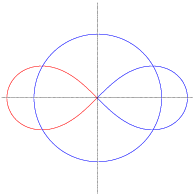
Solve simultaneously:

![]() equals
equals ![]() when
when ![]() is
is ![]() or
or ![]() . I have to add
. I have to add ![]() to get 2 sets of values, since the
argument is
to get 2 sets of values, since the
argument is ![]() :
:

Then

Note that there are four intersection points in the picture.![]()
Derivatives in polar coordinates. Here's how
to find ![]() for a polar curve. The idea is to use the
Chain Rule and the conversion formulas
for a polar curve. The idea is to use the
Chain Rule and the conversion formulas ![]() and
and ![]() .
.

Example. Find the equation of the tangent line
to ![]() at
at ![]() .
.
When ![]() ,
, ![]() . The point of tangency is given by
. The point of tangency is given by
![]()
Now
![]()
Thus,

The tangent line is
![]()
Example. Find ![]() at the point
at the point ![]() on the polar curve
on the polar curve
![]()
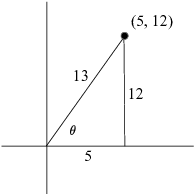
By Pythagoras' theorem, the hypotenuse is ![]() . I can also read off
. I can also read off
![]()
Now
![]()
Since ![]() , I have
, I have
![]()
Then

Copyright 2019 by Bruce Ikenaga